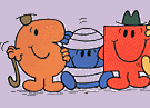

| The Mr. Men | |
|---|---|

Mr. Topsy Turvy, Mr. Bump and Mr. Strong enjoying a Mr. Men reunion |
The Mr. Men were picture book characters created by Roger Hargreaves in the early seventies. They were used as a tool to get across the ideas of basic morality, ethics and generally how to make the world a nicer place.
The characterisation style was simplicity itself each of the Mr. Men would be based around a single concept which was generally represented by simple geometric shape and colour. On to this basic shape was placed a face, limbs and usually a hat (sometimes used as a plot device, see Mr. Chatterbox for more information). Often small variations were then added e.g Mr. Tickle's long arms, Mr. Bumps bandages and Mr. Uppity's monocle. That was the basis of each Mr. Man. Then the story would generally consist of a mix of a description of the character's wacky lifestyle and an adventure of some sort with possible cameos from other Mr. Men. Often some sort of ironic punishment was inflicted. The classic example being Mr. Tickle having his extra-long arms reduced to normal size becoming Mr. Used-To-Tickle until he had learnt his lesson. The other common plot was that of making the world a better place by improving a dull life. Examples of this being Mr. Happy making a sad version of himself happy and Mr. Impossible allowing a school boy to escape the boredom of the classroom by having impossible adventures. The books eventually became an animated series with ditty tune and narration from a friendly Arthur Lowe. In the Eighties it was updated by adding the Little Misses (for political correctness). John Alderton (who wasn't in Dad's Army)became the narrator and a more upbeat tempo replaced the original theme tune. See a selection of Mr Men Book Covers in the Rogues Gallery |
| Space 1999 | |
|---|---|
 An obvious case of giving a programme a cool sounding title |
This programme seemed to be constantly repeated on Saturday mornings up until the early eighties. The premise was a bit silly but excusable. For anyone who doesn't know the idea was that in the near future the moon would be used to store dangerous nuclear waste (ok so far) which one day decides for no good reason to blow up (ok) and send the moon hurtling out of the Earth's orbit and through space taking with it all the inhabitants of the local space base (which is where "sensible idea" goes out the window).
So this gallant group of individuals spent their time travelling on the moon from adventure to adventure, losing transport ships (called Eagles) and crew nearly every episode. They also used technology levels far more advanced than was likely. I should not be too critical some of it wasn't too bad and the programme itself has quite a large group of fans on the web and if I critisise it too much they might beat me up. (only joking) See a selection of Space 1999 characters in the Rogues Gallery |